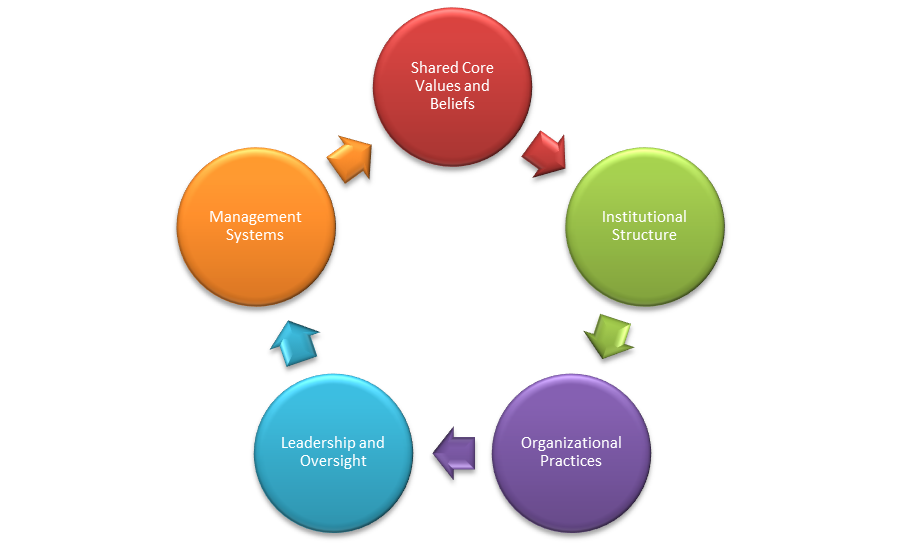Lesson 3: Culture
Attention

Within the culture of this classroom there are many parts...the class is also part of a broader culture of KVCC, State of Maine, United States, etc. etc. etc.
We will examine this COURSE in light of the components of organizational culture outlined in the graphic above.
Learning Outcomes
Upon completion of this lesson's material, students will be able to:
- Discuss Xenophobia from a personal and cultural-problem point of view.
- Identify personal instances of subculture, counterculture, pop culture, and co-culture.
- Apply the Sociological Perspectives to an analysis of components of culture.
Teaching
Culture is to us like water is to a fish...it surrounds us, penetrates us, and we are often not aware of it being something special that sustains us!
Culture
Culture embodies nearly every aspect of our surroundings and out thinking. As we will see later, we are socialized, or taught, about our culture from the first day we are on Earth. The learned and shared behaviors, beliefs, attitudes, values, and material objects that characterize a particular group or society.
- Material Culture - Objects and technology that characterize a group or society.
- Non-material Culture - Values, norms and expectations that characterize a group or society.
- Symbols and Language
- Cultural Universals - Aspects of culture that are found (in one form or another) in all societies.
EXAMPLE...Culture in the Classroom This class has a culture...it is defined by the institution (KVCC), the leadership (Teacher), and by the members (Students).
|
Ethnocentrism and Xenophobia
We tend to prefer what we are used to. So, our own culture seems to fit right with us more than dramatically different cultures. This is a shared experience among many people and it is referred to as Ethnocentrism.
The opposite of ethnocentrism is the believe that ANOTHER culture is superior to our own, this is called Xenocentrism. The US is faced with some challenges in regard to FEARS about other cultures, a concept known as Xenophobia.
This impacts our relationships with many different people that we may encounter including people of different sexual orientation and different cultural backgrounds (such as Muslims).
This is a really brief video defining Xenophobia.
This video is a particularly long debate on Xenophobia...over 2 hours long...this is optional material.
Pluralistic Societies
Pluralistic societies, such as the US, contain lots of smaller cultures within the larger US culture. Consider the following terms:
- Pop Culture
- Counterculture
- Subculture
- Co-culture
Each of these refers to a separate set of "Norms, Values, Expectations, Language, Symbols, and Material Culture" within the larger, primary culture...let's say, the US.
When we study groups, we will see that each group has its own culture. Depending on the nature of these unique cultural components, the group falls into one of the categories.
Applying the Perspectives on Culture
Consider the Sociological Perspectives that we learned about in Lesson 1. They are listed below with short, one-line descriptions.
- Functional - society is a stable, orderly system characterized by societal consensus
- Conflict - groups with divergent interests engage in ongoing power struggles for control of scarce resources in society
- Symbolic Interactionist - the meaning that individuals and groups attribute to culture, society, and social interactions
- Post Modern - explaining social life in contemporary societies that are characterized by post-industrialization, consumerism, and global communications
Consider different aspects of your cultural knowledge (a practice of creating the Sociological Imagination!) How can you view any single aspect of your culture from each of these perspectives?
How would you view your college experience from each of these perspectives?
Assessment
The Online Discussions are for students who are taking Online and Hybrid versions of this class. Your Instructor will inform you if you have to pay attention to these...otherwise you can ignore them.
Lesson 3 Discussion A
While it may be uncomfortable to share our own personal Xenophobic tendencies, this IS the course where we talk about such things! Share any personal thoughts or experiences about Xenophobia. How can this issue be both a PERSONAL and a CULTURAL problem?
Lesson 3 Discussion B
Share information about your personal membership in and of the alternative cultures that are listed in the Lesson. Keep in mind these are hardly ever negative and some aspects of your culture (such as the work you do or whether you have tattoos or not) are considered in this category.
Lesson 3 Quiz
For this quiz you are going to select a single component of your own personal culture and apply each of the four Perspectives to an analysis of that component. For each Perspective provide a single paragraph outlining the Perspective.
- Functional
- Conflict
- Symbolic Interactionist
- Post Modern